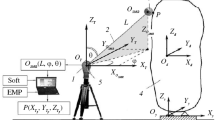Abstract
Geometric errors are the main reason for the inaccuracy of all machines. Measuring these errors and compensating for them will enhance the accuracy of machines themselves. This paper proposes a new systematic methodology to measure generalized geometric errors of a novel coordinate measuring machine based on a laser tracker that can obtain a full pose of measured points. Based on this methodology, a computer program has been developed that can perform error analysis on any serial link. This methodology is applied to the error analysis of a new type of coordinate measuring machine, which has two rotary joints and one linear joint. The obtained results show that generalized geometric errors can be successfully identified, and the accuracy of the experimented machine is considerably improved, thereby reducing maximum position errors from a few millimeters to approximately 50 μm after error compensation.









Similar content being viewed by others
References
Wu CH (1983) The kinematic error model for the design of robot manipulator. Proceeding of the American control conference, pp 497–502
Veitschegger W, Wu CH (1986) Robot accuracy analysis based on kinematics. IEEE J Robot Autom 2:171–179
Samad H, Kam T, Gerald R (1988) Robot geometry calibration. Proceedings of IEEE international conference on Robotics and Automation, pp 947–951
Roth ZS, Mooring B, Ravani B (1987) An overview of robot calibration. IEEE J Robot Autom 3:377–385
Paulo CM, Tim K, Jim D (1996) Cmm verification: a survey. Measurement 17:1–16
Soons J, Theus F, Schellekens P (1992) Modelling the errors of multi-axis machines: a general methodology. Precis Eng 14:5–19
Eman KF, Wu BT, DeVries MF (1987) A generalized geometric error model for multi-axis machines. Ann CIRP 36:253–256
Chen J, Chao LM (1987) Positioning error analysis for robot manipulators with all rotary joints. IEEE J Robot Autom 3:539–545
Waldron K, Kumar V (1979) Development of a theory of errors for manipulators. Proceedings of the Fifth World Congress on the Theory of Machines and Mechanisms, pp 821–826
Benhabib B, Fenton R, Goldenberg A (1987) Computer-aided joint error analysis of robots. IEEE J Robot Autom 3:317–322
Ferreira P, Liu R (1986) An analytical quadratic model for the geometric error of a machine tool. J Manuf Syst 5:51–63
Robert JH, Paulo HP (2011) Coordinate measuring machines and systems, Second edn. CRC Press, NW, USA
Vaichav R, Magrab E (1987) A general procedure to evaluate robot positioning errors. Int J Robot Res 6:59–74
Schwenke H, Knapp W, Haitjema H, Weckenmann A, Schmitt R, Delbressine F (2008) Geometric error measurement and compensation of machines-an update. CIRP Ann Manuf Technol 57:660–675
Slocum AH (1992) Precision machine design. Prentice-Hall, Inc., New Jersey, USA
Strang G (1992) Culculus. Wellesley-Cambridge, Wellesley, MA, USA
Acknowledgements
This work was supported by a grant from Inje University for the Research in 2015(20150498).
Author information
Authors and Affiliations
Corresponding authors
Rights and permissions
About this article
Cite this article
Vo, A., Tran, N., Duong, T. et al. A New Method for Measuring Generalized Geometric Errors for a New Type of Coordinate Measuring Machine Using a Laser Tracker. Exp Tech 41, 463–473 (2017). https://doi.org/10.1007/s40799-017-0186-1
Received:
Accepted:
Published:
Issue Date:
DOI: https://doi.org/10.1007/s40799-017-0186-1




